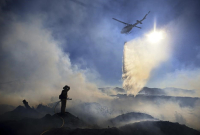Support strong Canadian climate journalism for 2025
BOISE, Idaho (AP) — Airport officials facing jet fuel shortages are concerned they’ll have to wave off planes and helicopters that drop fire retardants during what could be a ferocious wildfire season, potentially endangering surrounding communities.
Sporadic shortages at some tanker bases in Oregon and Utah have already been reported. The worry is that multiple bases go dry simultaneously during what is shaping up to be a very busy wildfire season in the U.S. West. Tanker bases in Arizona, where many large fires are burning, have also had jet fuel supply issues in the last month.
“We haven’t run into that before,” said Jessica Gardetto, a National Interagency Fire Center spokeswoman in Boise, Idaho, and a former wildland firefighter. “It’s a scary thought, with all the shortages going on right now.”
Airport officials, aviation supply companies and jet fuel transport companies said jet fuel demand declined sharply and supply chains atrophied during the coronavirus pandemic. They have yet to bounce back in the Western U.S. even as the economy zooms ahead and more passengers flock to airports for long-delayed trips.
According to the U.S. Energy Information Administration, jet fuel supplied in the U.S. in 2020 fell 38 per cent compared to 2019 pre-pandemic levels. Jet fuel demand has increased about 26 per cent since the start of this year, though it hasn't reached 2019 levels. The administration's Weekly Petroleum Status Report for July 2 shows demand at 78 per cent of 2019 levels. That's up from 44 per cent of 2019 levels for the same time period in 2020 when the pandemic had taken hold.
Overall, the administration said, jet fuel inventories in the U.S. are at or above the five-year average, except in the Rocky Mountains, where they are one per cent below. That appears to point to the supply chain as the potential problem, various industry officials said.
“COVID, it lulled everybody to sleep,” said Mark Haynes, vice-president of sales for Ann Arbor, Mich.-based Avfuel Corporation, which supplies jet fuel across the U.S., including to about half of the nation’s 44 air tanker bases operated by the U.S. Forest Service or U.S. Bureau of Land Management in western states. Some states also maintain tanker bases.
“Our business went to about zero," Haynes said. "A lot of trucking companies had to lay off (jet fuel) drivers. What happened with the opening up of the U.S., demand for leisure travel has boomed.”
Chris Kunkle is vice-president of operations for the Central Coast Jet Center in Santa Maria, Calif. It’s a private airport known as a fixed based operator that provides services for private jets, such as refuelling. It also serves as a Forest Service air tanker base, and is large enough for DC-10 air tankers.
“In the blink of an eye, we can have a fire here within our response area that can bring in one to three DC-10s and a bunch of variable-sized air tankers,” he said. “We can go from a couple thousand gallons (3,800 litres) a day to 50,000 (190,000 litres) to 60,000 gallons (227,000 litres).”
He said he likes to keep 60,000 gallons (227,000 litres) at the airport, but is having trouble with limited deliveries. He fears running out if a large fire breaks out in the area.
Decisions on where the fuel goes can be difficult. Commercial jet travel can be a huge economic driver in many communities. Air ambulances also need fuel. Industry officials said problems at large commercial carriers this year appear to have more to do with worker and pilot shortages than lack of jet fuel.
Jeff Cyphers of Stockton, Calif.-based Humboldt Pacific LCC, said he's expanding the company's fleet of 20 jet fuel tanker trucks to transport fuel to West Coast states and, during the wildfire season, Idaho, Montana and Utah. He said there's currently both a shortage of drivers as well as jet fuel to deliver.
“The supply chain right now is probably the most fragile I've ever seen in my years of experience,” said Cyphers, who has been in the industry since 1986.
Most larger airports such as those in Denver, Seattle and Boise are supplied by pipeline. But many smaller, outlying airports such as those in Aspen, Colo., and Jackson, Wyo., and Hailey, Idaho, near the resort town of Sun Valley, rely on jet fuel delivery by truck. So do many of the airports with tanker bases, some of them hundreds of miles away from jet fuel refineries or pipelines.
Cyphers said his company has even been trucking jet fuel to airports supplied by pipeline because they hadn't received their full allocation of jet fuel.
Hundreds of aircraft are used to fight wildfires each year. Most of the nation’s large retardant bombers are jets. Turboprop retardant bombers also use jet fuel. They lay down strips of red fire retardant ahead of approaching flames in support of ground crews who are more likely to hold a fire line after a retardant bomber has made a drop.
Most firefighting helicopters also use jet fuel.
It's not clear if jet fuel supplies and delivery systems can be bolstered in time for this wildfire season to avoid potential problems keeping firefighting aircraft aloft if multiple large fires break out around the West.
“Not this year,” predicted Cyphers, from the trucking company. “I could be wrong, but I don't foresee them being able to bridge that gap."





Comments